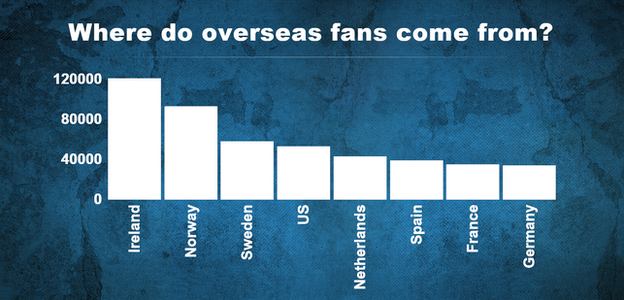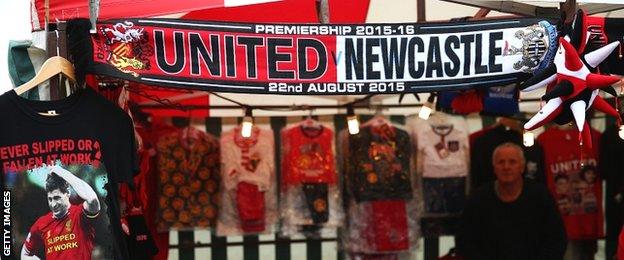Overseas football fans visiting Britain now at 800,000
- Published

Old Trafford, along with Emirates Stadium, is the most visited in Britain with 109,000 coming from overseas
The number of overseas fans visiting Britain to watch top-flight football rose to 800,000 in 2014 and brought in £684m, according to research.
Most fans came from the Republic of Ireland (121,000), with Norway (93,000), Sweden (58,000) and the United States (53,000) next.
Old Trafford and Arsenal's Emirates Stadium were the most popular venues, both receiving 109,000 visits each.
Premier League chief Richard Scudamore said the rise was "very encouraging".
Supporters' Chair: 'Concerns over tourist ticket distribution'
However, football supporters groups said the figures, released by tourism body Visit Britain, underlined concerns they have about the make-up of fans in stadiums, ticket prices and club identity.
The last time Visit Britain - which has a partnership with the Premier League to encourage visitors to come to Britain and see a live match - published figures was in 2010, when 50,000 fewer fans attended games.
The Norwegian branch of the Liverpool Supporters' Club estimates that for big games, up to 1,500 Norwegians descend on Anfield.
The Premier League is already a huge global brand with an estimated 1.2bn fans worldwide and overseas TV rights expected to exceed the £2bn which was paid for the last deal running from the 2016-17 season.
The research shows that fans want to experience that excitement in person, which in turn is boosting the British economy.

Republic of Ireland accounted for 121,000 of 800,000 fans visiting Britain to watch top-flight football
Boosting Britain's economy
Visit Britain says it is targeting key markets across the globe through its 'Football is Great' campaign, which includes a video from Manchester United assistant manager Ryan Giggs on the ease of travelling around the country.
And from a financial point of view, it appears to be paying off.
The 800,000 overseas fans who watched football in Britain last year spent £684m collectively, up £89m since 2010. On average they were likely to spend £855 per visit, considerably higher than those who chose not to watch football at £628.
Football also appears to be a good way of encouraging visitors to Britain in winter months while the football season continues, with 31% of visitors from January to March taking in matches, compared with 19% in July to September.
Almost three quarters (73%) of visitors who gave their primary journey purpose as watching sport said they had attended a football match.
Manchester taxi drivers will tell you how much busier they are on match days when Manchester United are at home, and it is clear that football is a big attraction to the area.
Ten percent of visitors to the North West of England, which is also the home of Manchester City and Liverpool, head to the region to watch football, compared to 5.6% in the north-east and just 1.3 in the south-east.
Tourism minister Tracey Crouch said: "It's fantastic to see the positive role football is playing in showcasing key destinations in many different regions of the UK."

Fans merchandise is often geared towards overseas tourism
What is the appeal?
Tore Hansen is the chief executive of the official Norway branch of the Liverpool Supporters' Club and has been travelling to Anfield for the past 30 years.
He says the love affair started in the 1960s when many Norwegians adopted English teams as a result of games being screened on TV. He also believes the numerous flight routes to Britain have made it easier for fans to travel.
"It's been building for many years," he told BBC Sport. "One of the reasons was because the standard of football in Norway wasn't that great. British football has always been popular in Norway and it's also a nice country to visit."
So popular in fact, that the clamour for tickets has increased at Anfield, a stadium which holds 45,500 fans and is dwarfed by the 60,000 capacity at Emirates Stadium and 75,700 at Old Trafford.
Hansen, 48, says that some Norwegian fans end up buying from season ticket holders, with some choosing to sell their seats every week. He also says there are many examples of fans paying for tickets on the internet, never to see them in person.
"The demand is massive and it's a shame it's gone that way, especially for local people in Liverpool," he added.
The Premier League says that stadiums were at 96% capacity last season.

Liverpool is expanding its stadium to 59,000 seats for the start of the 2016-17 season
Keeping a club's heritage
Manchester United Supporters Trust (MUST) vice-chairman Sean Bones says there needs to be equilibrium between welcoming overseas fans and maintaining the club's heritage.
Asked whether a local or overseas supporter was considered more important by clubs, he said: "Manchester United has been built by generations of local support and we deserve that recognition. It's a question of balance, the fact we are so attractive to tourists is because of our history."
Bones also has concerns about the demand for tickets increasing prices. A BBC study found that the average price of cheapest tickets in England has increased by 13% since 2011, with the Football Supporters' Federation calling for clubs to reduce their cost.
Bones told BBC Sport: "It's good for the country when additional funds come into the economy but we need clubs to reward the long-term loyalty of our supporters."
As for whether overseas fans contribute to subdued atmospheres at Old Trafford, Bones says: "That's probably more to do with all-seater stadiums."
Most visited stadiums in Britain by overseas fans |
|---|
Old Trafford (Manchester United): 109,000 |
Emirates Stadium (Arsenal): 109,000 |
Anfield (Liverpool): 99,000 |
Stamford Bridge (Chelsea): 89,000 |
Wembley (England): 51,000 |
White Hart Lane (Tottenham): 40,000 |
Etihad Stadium (Manchester City): 33,000 |
Craven Cottage (Fulham): 30,000 |
Will numbers of overseas fans increase?
The top-10 largest markets for overseas visitors to British football are limited to European countries, the US and Australia.
But Visit Britain believes that the growth of the Premier League's appeal in Asia means the established order may not remain for long.
"The London 2012 Olympics put Britain on the map as the home of sport, and obviously football is a global draw," says Patricia Yates from Visit Britain.
"It's interesting to see the strong appeal it has in new-growth markets like China, Hong Kong and Indonesia where those new out-bound travellers tend to be younger and affluent. They have the same loyalty to their clubs as British fans and they want to come and see them play in the stadium."
£1,300 to watch your team play? |
|---|
Read about one South African fan's journey to watch his beloved Manchester United play at Old Trafford. |
Like Bones, Yates believes there needs to be a balance between local and overseas supporters but argues that foreign fans "add to the flavour of the match".
As for overseas football visitors reaching the 1m mark, do not expect Visit Britain to halt its use of the Premier League as key marketing tool.
"In 2014, we saw 35m people come to Britain where they spent £22bn, and we plan to grow that to 40m by 2020," Yates added. "So we have ambitious targets and we will continue to use football as a major draw to this country."
As Hansen says, the Anfield Stadium expansion has come at just the right time.
- Published10 September 2015

- Published9 September 2015

- Published9 September 2015

- Published10 February 2015

- Published10 August 2015

- Published20 June 2016

- Published7 June 2019
